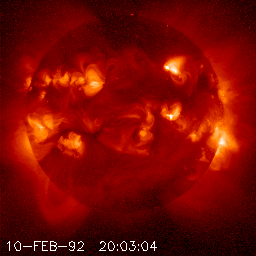Introduction to the Sun-Earth Relationship
Do two guns really produce two different bullets?
The fundamental question that our research hopes to answer is whether there is a difference between magnetic clouds occurring from disappearing filaments and those originating from sigmoids, and if so, can the sources of these magnetic clouds be used as accurate predictors for the severity of the ensuing magnetic storms occurring at 1 AU. Also, by using a model to fit these magnetic clouds, can we determine, before the eruption even occurs on the surface of the Sun, what the orientation and composition of the cloud will be? To this end, we are compiling a list of magnetic clouds. The details of this list can be found here.

|
In compiling this list we used a combination of data from Yohkoh/SXT, SoHO/EIT/LASCO,
ACE and Wind. The first step was to take the list of events at 1 AU and trace
them back to their source on the Sun. We spent countless hours viewing Yohkoh
movies such as the one to the left. Indicators that "something" happened include
a sudden brightening, drastic change in structure, movement of mass and large
time gaps in the full Sun images. Large time gaps usually mean that Yohkoh stopped
taking full Sun images to focus in on a flare and this could be the possible
source. When Yohkoh data was inconclusive or needed corroboration we used data
from SoHO, mostly viewing and creating difference movies to see what features
underwent drastic changes. We supplemented this information by viewing images of
the Sun in Ultra-Violet as well as H-alph, in order to get a different look at
what was going on, as well as view any possible disappearing filaments. Locating the exact source of a magnetic cloud, however, is a very difficult process. Often times there are several eruptions within the time period that the progenitor is likely to have erupted. This has proven and will continue to be the most difficult part of our research. Therefore, we moved on to more productive aspects of our research. |
